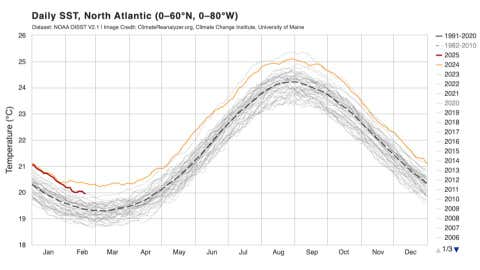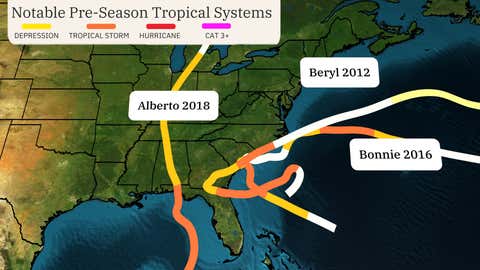
CLICK HERE TO JOIN OUR WHAT’S APP GROUP
SOURCE: THE WEATHER CHANNEL- Feb. 21 marks 100 days until the official start of the 2025 Atlantic hurricane season. This countdown allows us to look ahead at how the season might shake out, how to get ready and to look back at storms that occurred before the season began.
1. What We Know About This Hurricane Season
While it is much too early to know many details of how bad this hurricane season might be, we do have a few clues.
The first is the status of ENSO (El Niño – Southern Oscillation). The status of ENSO can often stack the deck toward being more or less active. This year, however, that deck hasn’t been stacked in either direction. The good news is that the expectation of a neutral year might bring a less active year.
(MORE: What Is El Niño?)
The second factor is water temperatures. As has been the case for the better part of the last decade, water temperatures are running above average across the basin, but also slightly cooler than last year’s scorcher.

A spot in the basin becomes viable for tropical activity when water temperatures reach roughly 80 degrees (or 27.5 degrees Celsius on this map). This is roughly when hurricane season begins. The Caribbean is already warm enough to sustain tropical activity, but we have no sources for tropical development there (cold fronts, upper-level lows, tropical waves) this early in the year.
The Caribbean, Gulf and western Atlantic are typically the first spots we watch for tropical development because those areas warm up the earliest.
The Gulf is several degrees warmer than average for this time of the year, and if sustained for several months, that could lead to more development. The Gulf is more susceptible to temperature changes in the spring due to the infiltration of cold fronts and blasts of arctic air, so this warm pocket may not stick around.
For now, based on these two signals, one would think an average to slightly above-average hurricane season is ahead, but with 100 days left before the season begins and some 200 days until the peak of the season, we’ll learn a lot about how the season will play out soon enough.
(MORE: Hurricane Season Terms You Should Know)
2. Hurricane Season Can Start Early
Now is the perfect time for a reminder that the calendar isn’t always the best marker for when the season starts. Many recent years have had storms develop before June 1, the official start of hurricane season.
Most recently, in 2023, Tropical Storm Arlene went backward through the Gulf, moving southward instead of the typical north or northeastward.
In 2016, Tropical Storm Bonnie soaked the coast of the Carolinas in late May. That was preceded by Eastern Atlantic Hurricane Alex, only the second known January Atlantic hurricane. Alex eventually made landfall in the Azores as a tropical storm.
In 2012, Tropical Storm Beryl almost reached hurricane strength before landfall on Memorial Day weekend in northeast Florida.

(MORE: 7 Things Florida Newcomers Should Know About Hurricanes)
3. What You Can Do In The Next 100 Days
– Get flood insurance: If you are in a spot that has ever flooded in any scenario, looking at flood insurance is worth your time. The inland threat from hurricanes continues to grow. This includes everyone from the Appalachians (devastated by Hurricane Helene) to the Ohio Valley and even the Northeast. Even parts of California and Arizona are seeing new threats from tropical systems. Remember, flooding is not likely to be covered by your homeowner’s insurance, and it can take more than a month to obtain flood insurance. It is too late to get this kind of insurance when you see a hurricane coming.
– Review plans: Have an evacuation plan in place with your family and know your evacuation zone. Know where your hurricane kit is and where all of your must-have items are. If you have the time and resources, a dry run to your evacuation spot can calm your nerves when the time comes.

– Save money: Make sure you have an emergency fund for whenever the unthinkable happens. A lot of people think this requires thousands of dollars, but it can be just a few dollars a week transferred into a savings account that can grow. After you have a substantial “uh oh” fund put together, start buying upgrades to your hurricane kit. Add an occasional batch of batteries or a flashlight when you have a few extra dollars. You’ll thank yourself later.
– Know where to vacation – and where not to vacation: Save yourself the headache, and please don’t plan large vacations in the middle of hurricane season (August to October) in the Caribbean or Mexican Riviera. This is a prime time for travel disasters.
Jonathan Belles has been a graphics meteorologist and writer for weather.com for 8 years and also assists in the production of videos for The Weather Channel en español. His favorite weather is tropical weather, but also enjoys covering high-impact weather and news stories and winter storms. He’s a two-time graduate of Florida State University and a proud graduate of St. Petersburg College.
Credit to Levi Cowan/Tropical Tidbits for graphics used in this story.
CLICK HERE TO JOIN OUR WHAT’S APP GROUP
CLICK HERE TO JOIN OUR WHAT’S APP GROUP
CLICK HERE TO JOIN OUR WHAT’S APP GROUP
CLICK HERE TO JOIN OUR WHAT’S APP GROUP
CLICK HERE TO JOIN OUR WHAT’S APP GROUP
CLICK HERE TO JOIN OUR WHAT’S APP GROUP
CLICK HERE TO JOIN OUR WHAT’S APP GROUP
Advertise with the mоѕt vіѕіtеd nеwѕ ѕіtе іn Antigua!
We offer fully customizable and flexible digital marketing packages.
Contact us at [email protected]


















Hope the government is also preparing, not just telling us to!
Don’t Forget to check insurances early —too many people wait until it’s too late.
Wish they included more details on what this season’s forecast actually looks like.
I appreciate the heads-up, but let’s also talk about how climate change is making storms worse.
Stocking up early on supplies is a great tip, but prices always go up before storms hit.
Thank you for the reminder and the information, It’s appreciated
Comments are closed.